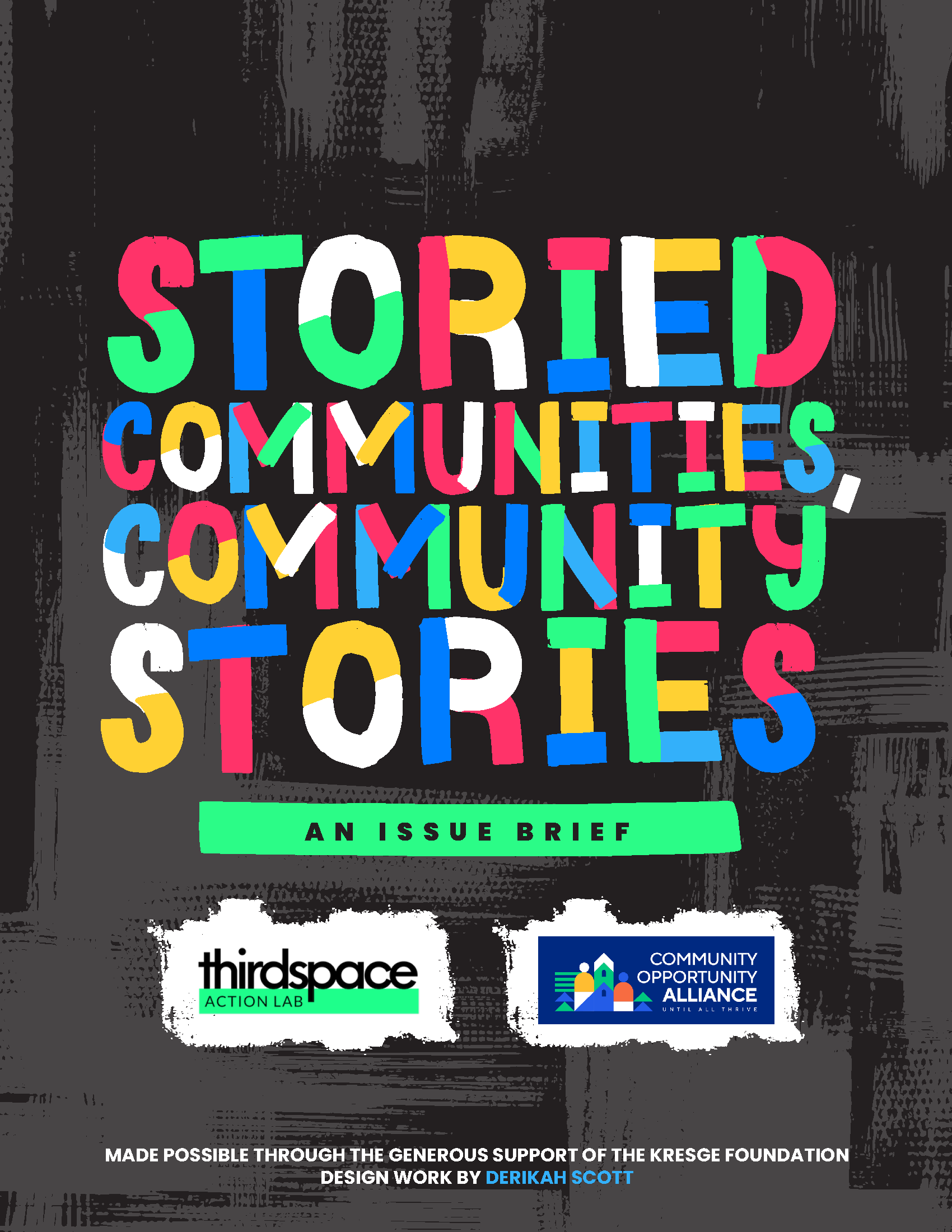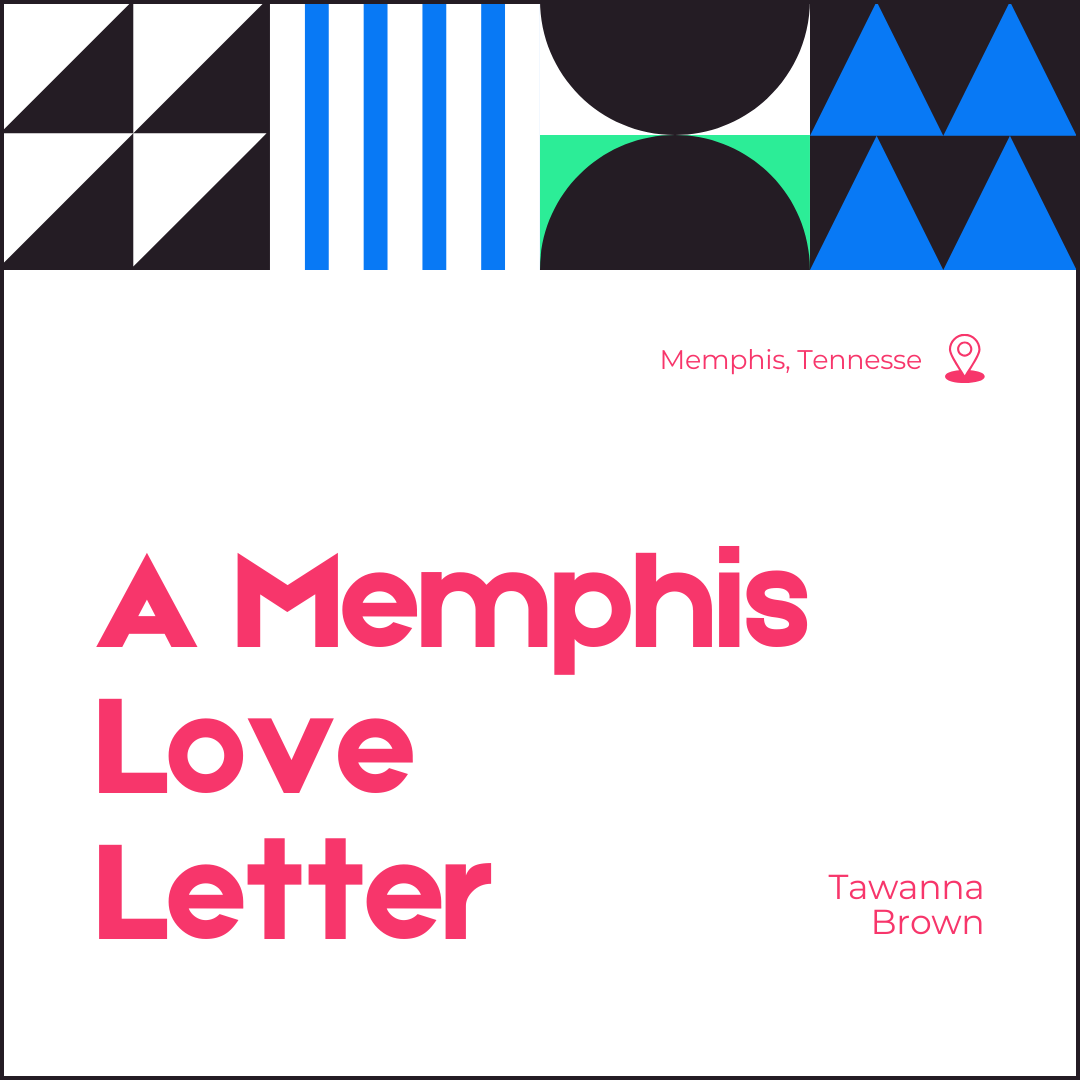Artists Leading and Learning in Community Development
Learning from the work of Storied Communities, Community Stories
Nadia Elokdah and Eddie Torres
Cover image: Storied Communities, Community Stories Issue Brief. Courtesy of Community Opportunity Alliance.
Prologue: Advancing Art at the Intersection
Arts and culture can completely change how we connect, dream, and solve problems. That’s at the heart of why Grantmakers in the Arts (GIA) launched the Art at the Intersection research project, which started with a big, bold idea: what if arts and culture were deeply woven into the strategies we use to tackle big challenges like racial, economic, and social justice? Not just as an add-on, but as a core part of the solution.
The research explored how the arts can help communities thrive — using creativity to spark conversations, shift perspectives, and build relationships across differences, creating space for new ideas, identities, and behaviors to emerge. It also pointed out where funding and focus could make the biggest difference, such as workforce development, public health, and rethinking how systems like policing and courts impact children. Arts and culture often bring people together, and this work demonstrates how that same energy can help drive real, lasting change in our communities, especially in areas that might not typically be associated with the arts.
What’s particularly exciting is how this connects to creative place-making — and place-keeping [1] and place-knowing [2] — and community development. Art and culture can shift the atmosphere, supporting folks knowing each other across difference, to share experiences and hold meaningful dialogue. This can lead to mutual understanding and a shared sense of purpose — arguably the foundation of meaningful collective action. It’s not just about beautifying spaces or hosting events; it’s about centering culture and creativity as essential tools to build equity and belonging. It’s about recognizing the vital role of the arts in shaping how we live, work, and grow together. Now, the field is looking at ways to deepen this work, strengthen collaboration, and ensure communities are leading the way.
This research culminated in the report, Opportunities at the Intersections: Advancing Racial Equity via Arts and Culture in the Public Sector, written by Jen Cole and Rebecca Kinslow. The report inspired and informed the Cultural Policy Learning Series & Action Lab, and extended their influence beyond public agency practices into the community development field. One of the project’s research partners, Community Opportunity Alliance (the Alliance), explored the origins of community development, examining who supports it and why. One of their findings underscored a critical insight: the community development field has gradually drifted away from supporting organizing for policy change, which the Alliance identified as a space where artists are particularly equipped to lead.
The Opportunities at the Intersections: Advancing Racial Equity via Arts and Culture in the Public Sector report inspired and informed the Cultural Policy Action Lab & Learning Series.
The Learning Series is a publicly accessible series of classes on such issues as racial equity and transformational practice in the public sector, translating between sectors, and planning toward action.
The report and action lab’s professional development series also inspired and informed GIA’s first public agency and policy track at the 2024 GIA annual conference in Chicago.
From There to Here: Connecting to Storied Communities, Community Stories
The central tenet behind the Art at the Intersection project is direct: arts and culture are powerful tools for driving social change, and artists are uniquely equipped to use these tools for collective learning and action. Bringing arts into the fold of community development means finding meaningful ways to integrate creativity into efforts tackling the large-scale challenges of racial and economic justice. This work shows how the intentional inclusion of arts and culture can spark transformation — shifting systems, building community power, and fostering collaboration across people and sectors to create lasting change. At its core, it’s about leveraging this transformative power as a path toward system-level shifts, nurturing of new relationships, and encouraging collective action across diverse contexts, including both public and private sectors.
One of the key takeaways for GIA from the Community Opportunity Alliance’s research was this: Encourage grantmakers to support community organizing. Community organizing has been shown to be an effective way to build resident engagement and support; it’s a strong fit for artists, it’s time-intensive, and yet, it’s seldom supported by existing community development funding. Learning from its role in GIA’s research, the Alliance began applying this methodology in its own work — telling the story of what community development does and could do — through continued research.
Offering a new home for this exploration through Grounding Values In Research, the Alliance wanted to inform their state-level advocacy while understanding how arts can support equitable community development while understanding what communities think of local community development organizations’ efforts. ThirdSpace Action Lab (TSAL) was brought in as a research partner to conduct qualitative studies of a series of cities, engaging artists to communicate what residents think of local community development organizations and efforts.
The result: Storied Communities, Community Stories, a comprehensive report with recommendations synthesized from resident storytellers in four communities in different regions of the country to examine how residents engage with their local community development organization. Storied Communities shares a common mission as GIA’s Art at the Intersection research: lifting up the important role that artists and cultural leaders play in their communities while pushing for racial, economic, and social justice.
Storied Communities shifts focus to the voices of residents — many of whom are artists or cultural leaders — and community-based development organizations (CBDOs) in the future of their neighborhoods. While we understand how arts can reshape broader systems, Storied Communities zooms in on the people at the heart of these communities — showing how their lived experiences and leadership are essential in community development and lasting change. When communities are given the space, resources, and recognition they deserve, the power of culture, creativity, and lived experience can drive truly transformative work.
Experience the Storytelling
“Who’s writing the stories about where we live and what our lives are like? In the rough and tumble of community development, things like stories and narratives can get lost in the mix. It’s time to prioritize being the authors of our own stories.” The artists and researchers invite us to delve into how folks are thinking about dominant narratives and stories in our communities — and what it takes to resource our own, more accurate depictions.
— ThirdSpace Action Lab’s The People’s Practice, third edition
Where to Go from Here
Building from these artists' voices, directly from their own experiences with and within their own communities, how might someone experiencing this work proceed? Well, perhaps we should look no further than the Storied Communities report itself - with recommendation number four: Increase commitment, resourcing, and prioritization of resident engagement.
ThirdSpace’s separate research around the history of race, place, and the community development sector showed that the origin of community development was less about housing development and business development and more about residents exercising their ability to choose issues most significant to them and secure resources and government support to develop and implement their own solutions. Community development began to formalize from these kinds of resident-led experiments, backed by Black churches and picked up as a key pillar of both the Civil Rights and Black Power movements.
Over time, community development has gravitated incrementally away from organizing and policy work and incrementally toward technical expertise, with a strong emphasis on real estate development. This has arguably led to better outcomes in the physical conditions of places, but the consequence has been that, rather than residents developing and implementing solutions for challenges, others have taken over defining and professionalizing community development. The overwhelming majority of interviewees put high value on these kinds of professionalized offerings of direct services. At the same time, they were strongly in favor of reorienting and reprioritizing systems change work and root cause work – whether they were familiar with or named this origin story of community development or not. Interviewees placed a particular importance on engaging young adults in this kind of work, which they suggested would lead to community development that better aligns with needs and aspirations of the current generation.
NOTES
[1] “Intervening in discussions about gentrification and placemaking, cultural activist Roberto Bedoya champions the creative resilience found in communities of color—and exemplified by the Chicano practice of Rasquachification—to suggest ‘placekeeping’ as a strategy for advancing racial justice goals.” Roberto Bedoya, “Spatial Justice: Rasquachification, Race and the City,” Creative Time Reports. September 15, 2014. https://creativetimereports.org/2014/09/15/spatial-justice-rasquachification-race-and-the-city/
[2] “‘Place-making’ is a term with origins in the discipline of landscape architecture but absorbed into urban planning, development, and community engagement. ‘Place-keeping’ and ‘place-knowing’ have emerged as compliments (and sometimes counterpoints) to place-making. Taken together, these overlapping concepts form a good critical lens for examining grassroots-level organizing — or city systems and institutions.” Roberto Bedoya and Tom DeCaigny, “Belonging Is a Sticky Word: Roberto Bedoya in Conversation with Tom DeCaigny,” Open Space, SFMOMA. Published February 22, 2021. https://openspace.sfmoma.org/2021/02/belonging-is-a-sticky-word-roberto-bedoya-in-conversation-with-tom-decaigny/
ABOUT THE AUTHORS
Nadia Elokdah is vice president & director of programs at GIA; Eddie Torres is president & CEO at GIA.
This post is part of the Future of the Field: Cross-Sector Creative Placemaking Series.







